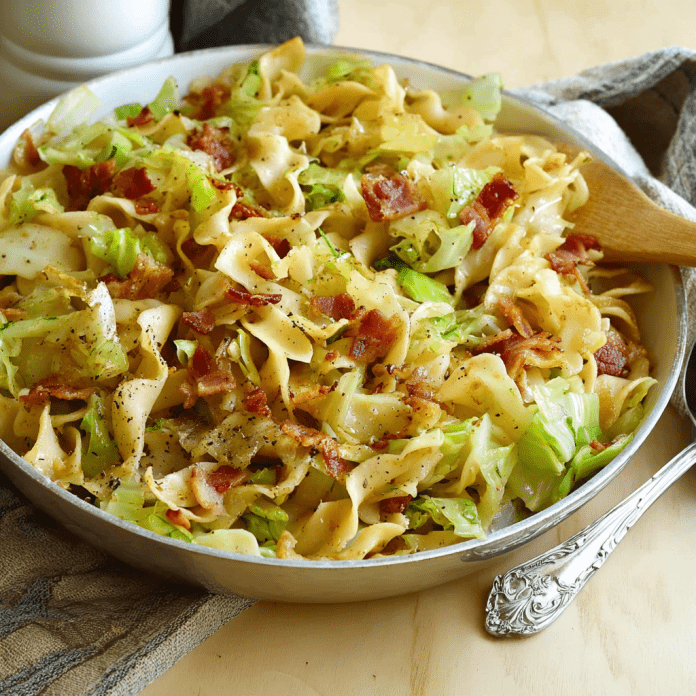Haluski is a cherished, humble dish of Eastern European origin that embodies the very soul of comfort food, transforming a few simple, inexpensive ingredients into a remarkably satisfying and flavorful meal. This recipe is a testament to the magic of slow-cooked, caramelized vegetables and their ability to create a dish that is far greater than the sum of its parts. At its heart, Haluski is a harmonious blend of soft egg noodles and tender, sweet cabbage, which is slowly cooked in a skillet until it becomes meltingly soft and takes on a subtle, nutty sweetness. The foundation of flavor is built with rendered bacon, which provides a rich, smoky backdrop, and sautéed onions, which add a deep, aromatic sweetness. A generous amount of butter is the final, essential component, tying everything together into a cohesive, glossy, and deeply comforting dish that is both rustic and elegant in its simplicity.
The true brilliance of Haluski lies in its straightforward technique and the incredible depth of flavor achieved through patience. The process of slowly cooking the cabbage over lower heat is non-negotiable; it allows the natural sugars within the leaves to caramelize gradually, developing a complex sweetness that is entirely different from the sharp, crunchy vegetable it starts as. When the buttery, drained egg noodles are added to the skillet, they eagerly soak up the rendered bacon fat, butter, and the savory juices released by the cabbage, becoming incredibly flavorful. Seasoned simply with a generous amount of black pepper, this dish is a perfect example of how peasant food can be the most delicious of all. Haluski is a versatile side dish that pairs wonderfully with pork chops or kielbasa, but it is also substantial enough to stand proudly as a vegetarian main course when the bacon is omitted, proving its enduring and adaptable appeal.
Why You’ll Love This Recipe:
- Ultimate Comfort Food: The combination of buttery noodles, sweet cabbage, and smoky bacon is incredibly soothing, hearty, and satisfying.
- Incredibly Economical: Made with pantry-staple and budget-friendly ingredients, this dish delivers a large quantity of delicious food for a very small cost.
- Simple and Straightforward: With minimal ingredients and uncomplicated steps, this is a foolproof recipe that is perfect for weeknight dinners.
- Versatile Side or Main: It functions beautifully as a side dish to roasted meats or can be a fulfilling vegetarian main (without the bacon) all on its own.

Ingredients:
- 8 ounces uncooked wide egg noodles
- 6 tablespoons butter, divided
- 6 slices bacon, uncooked and coarsely chopped
- 1 large yellow onion, chopped
- 2 cloves garlic, minced
- 1 ½ – 2 pounds green cabbage, cored and cut into bite-sized pieces
- Kosher salt, to taste
- Freshly ground black pepper, to taste
- Optional garnish: fresh chopped parsley
Instructions:
Step 1: Cook the Noodles
Bring a large pot of salted water to a boil. Cook the egg noodles according to the package directions until al dente. Drain well and set aside.
Step 2: Render the Bacon
While the noodles cook, melt 2 tablespoons of the butter in a large, high-walled skillet or Dutch oven over medium heat. Add the chopped bacon and cook, stirring occasionally, until it is about halfway to being crisp.
Step 3: Sauté the Aromatics
Add the chopped onion to the skillet with the bacon. Cook, stirring often, until the onion has softened and become translucent and the bacon is fully cooked and crisp, about 8-10 minutes.
Step 4: Cook the Garlic and Cabbage
Reduce the heat to medium-low. Add the minced garlic and cook for 30 seconds until fragrant. Begin adding the cabbage to the skillet in large handfuls, stirring after each addition. It will seem like a massive volume at first, but it will cook down significantly. Cook, stirring occasionally, for 15-20 minutes, until the cabbage is very tender and has begun to caramelize slightly at the edges.
Step 5: Combine Noodles and Cabbage
Add the remaining 4 tablespoons of butter to the skillet with the cabbage. Once melted, add the drained cooked egg noodles. Toss everything together gently but thoroughly until the noodles are coated in the butter and pan juices and are heated through.
Step 6: Season and Serve
Season the Haluski generously with kosher salt and a very generous amount of freshly ground black pepper. Toss once more, taste, and adjust seasoning if needed. Garnish with fresh parsley if desired, and serve hot.
Tips:
- Don’t Rush the Cabbage: The key to the best flavor is cooking the cabbage low and slow until it is very tender and sweet. Rushing this step over high heat will result in tougher, less flavorful cabbage.
- Reserve Pasta Water: Before draining the noodles, save about a half cup of the starchy cooking water. If the dish seems a bit dry when you combine everything, adding a splash of this water can help loosen it and make it sauciier.
- Vegetarian Version: To make a delicious vegetarian Haluski, simply omit the bacon. Use the full 6 tablespoons of butter to sauté the onions and consider adding a pinch of smoked paprika to mimic the smoky flavor.
- Customize It: Feel free to add other ingredients like sliced mushrooms (sautéed with the onions) or a dash of caraway seeds for an authentic Eastern European touch.
Storage Options:
- Refrigerator: Store leftovers in an airtight container in the refrigerator for up to 4 days.
- Reheating: Reheat gently in a skillet over medium-low heat with a small pat of butter or a splash of water to prevent sticking. The microwave can also be used, though the noodles may soften further.
- Freezing: Freezing is not recommended, as the cabbage and noodles will become mushy and release a lot of water upon thawing.


